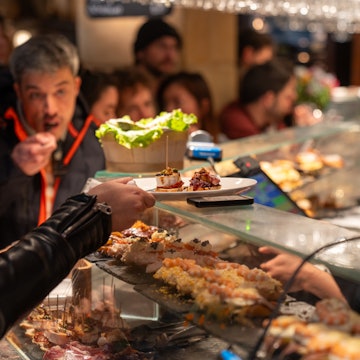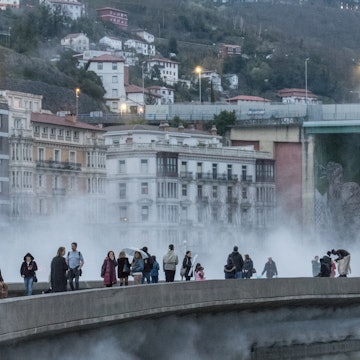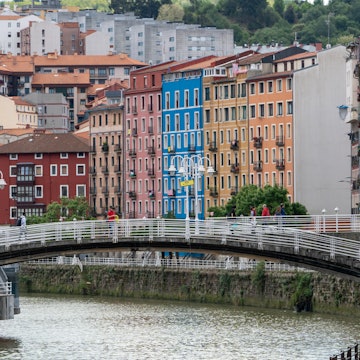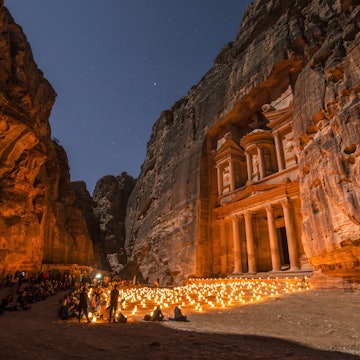

San Sebastian has been home to people since Paleolithic times, and its cider orchards date back to 1014, when the city as we know it began to grow © BARRERE Jean-Marc / hemis.fr via Getty Images
One of Spain's top tourist destinations, the charming resort town of San Sebastián (or Donostia, if you speak Basque) receives over 620,000 visitors per year. And while plenty flock to this picturesque coastal city for summertime surf and sun, a trip to San Sebastián in January affords advantages travelers may have not considered. From can't miss cultural experiences to unique access to renowned restaurants and more, here are 8 reasons to book a trip to San Sebastián in January.

Party on San Sebastián Day
Arguably one of the biggest days for Donostians, January 19th kicks off a 24 hour long, citywide celebration of all that makes San Sebastián special. Gastronomy clubs host traditional Basque dinners, then the town gathers at the town's main square, Plaza de la Constitución, to raise the flag. Marching bands and traditional drum parades (tamborrada) take to the streets until the evening of the 20th when the celebration concludes. If you want to truly immerse yourself in Basque culture, book your trip to coincide with San Sebastián Day.

Reservations at San Sebastián's Michelin-star restaurants
San Sebastián has more Michelin stars per square meter than any other city in the world – but getting a reservation during peak season can be challenging. While it's true that some of these acclaimed restaurants close their doors for the winter season, plenty of noteworthy eateries like Akelarre, and Kokotxa currently have available reservations in January (see full Michelin star list here).
San Sebastián cheap hotel rates
Hotel prices are at an all time low come January – which means waterfront accommodations like Hotel de Londres y de Inglaterra and Hotel Niza are less than $100 per night. Even high end hotels like the iconic Hotel María Cristina drops rates down to around $200 per night (as opposed to their $900 per night price tag come peak summer season). Royal luminaries like Queen Isabella II put San Sebastián on the map as a vacation destination – so why not treat yourself to a luxury stay without the royal price tag?

San Sebastián has mild winter weather
If you're worried about having to miss out on taking in the natural beauty and ornate architecture of San Sebastián due to winter weather constraints, you'll be happy to hear that the coastal town gets little to no snowfall in January. In fact, temperatures are pleasant, hovering around the high 50s, low 40s – ideal for strolling through the cobblestone streets of Parte Vieja, San Sebastián's Old Town, or taking a walk along the picturesque shorefront of Playa de la Concha.
San Sebastián's outdoor sculptures
San Sebastián's open air sculptures make the entire city feel like a work of art. If you pay a visit to the Peine del Viento sculpture in January, you'll have the opportunity to see the dichotomy of the fierceness of the sea amplified in juxtaposition with these impressive iron structures. The vision for sculptor Eduardo Chillida's creation was to create a conversation between his art and the surrounding landscape – and there's no better time to take that in than when waves are at their highest in January.

Visit San Sebastián's pintxos bars
Pintxos are small snacks signature to Spain's Basque region. They're elaborately crafted, designed to be eaten in just a few bites while enjoying drinks with friends at local bars. The best pintxo spots in San Sebastián are incredibly crowded during peak travel season – but a visit in January means you'll have your pick of prime pintxos no matter where you go. Stand out spots include made to order creations at La Cuchara de San Telmo, local staples at Ganbara and highly regarded Bergara Bar, but if you're wondering where to eat pintxos in January, you won't have to look far.
Celebrate Three Kings Day in San Sebastián
Just about everything in San Sebastián has deep religious roots – from the town's namesake, Saint Sebastian (patron saint of athletes and archers), to stunning 18th century churches as well as more modern sculptures (like the town's Cross of Peace). If you find yourself in Basque Country on January 5th, partake in the procession of the three kings through the streets of San Sebastián. Locals portray the biblical characters Gaspar, Melchior and Balthazar, and parade through the town's center streets to reach the town's City Hall. Afterward, enjoy a slice of Roscón De Reyes, a cream-filled cake decorated with "treasures" that represent the ones brought by the three kings to baby Jesus. If you're lucky enough to get the slice that has the baby king inside it, you'll have good luck all year (but have to pay for everyone's share of the cake, per Basque tradition).

San Sebastián cider season starts in January
January kicks off peak cider season in San Sebastián. Partake in the Basque tradition of drinking it straight from the barrel at one of San Sebastián's cider houses. If you hear someone yell "txotx," it's a signal to visitors that a new barrel has been opened, so gather round to catch a fresh glass! Many Basque cider houses charge per person, which includes an array of food items that typically pair with cider (a salt cod omelette, rare steak and local cheeses, to name a few).















